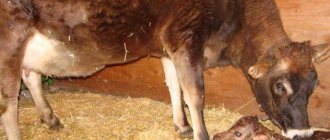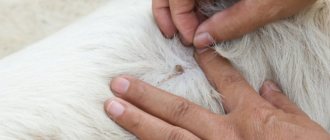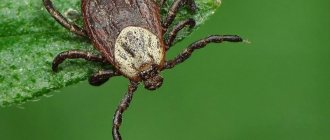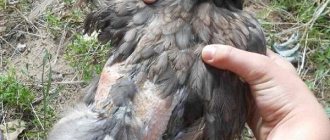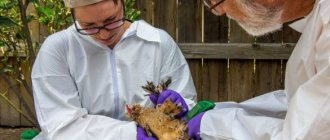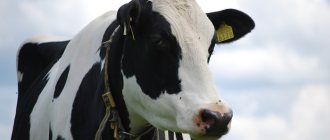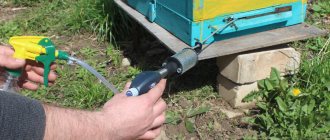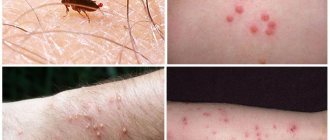Most species of domestic animals have an instinct to eat the placenta, which emerges from the birth canal after the birth of offspring. If after calving the farmer does not find the placenta, and the animal has signs of gastroenteritis, tympany, diarrhea with dark-colored feces, this allows us to conclude that the cow ate the afterbirth. If this does not pose a danger for dogs, cats, and rabbits, then in horses and cows, eating the placenta can provoke disturbances in the intestines and even lead to even more tragic consequences.
Cow with calf after calving
Expulsion of the placenta
Normally, the placenta comes out 4-8 hours after the calf is born. Even if after 8-10 hours no placenta is found near the animal, this is not a reason to worry. 12 hours after calving, the absence of a placenta will be a reason to call the veterinarian. A specialist will determine whether the afterbirth is inside or whether the cow ate it. Eating the placenta by herbivores is called placentophagy. Owners of farm animals should be aware of this condition.
The reasons for the delay of the placenta may be:
- weakness of the animal due to malnutrition;
- unbalanced food;
- significant distension of the uterus due to a large fetus or pregnancy with twins;
- chronic diseases of the cow, due to which she loses strength and attempts are weak;
- significant reduction in cow walking time;
- abnormal fetal development;
- obesity of the animal due to overfeeding;
- weakening of the animal after a difficult or prolonged calving.
Nutrition of pregnant cows and movement, even in the last weeks before calving, should be given increased attention, as this affects the birth process.
Retention of the placenta in the uterus and birth canal of an animal threatens the development of endometritis, vaginitis, mastitis and other pathologies. If 4 hours have passed after calving and the placenta has not yet appeared, it is necessary to stimulate its separation. One of the effective methods is to water the cow with her amniotic fluid. You can give from 2 to 4 liters. Hormonal substances that are in the amniotic fluid will stimulate the passage of the placenta, increase uterine contractions, etc.
It happens that the placenta fuses with the walls of the uterus, or for other reasons the placenta is not rejected for too long. Then medications are used. Pituitrin is administered subcutaneously, which contains a similar hormone responsible for contraction of the uterus and discharge of the placenta. The effect is observed after 10 minutes, the duration of action of the medication is 6 hours. Another drug Estradiol - dipropionate is administered intramuscularly also to contract the uterus.
What is afterbirth and what does it look like?
When a cow gives birth to a calf, calving ends with the process of separating the membranes that contained the fetus in the mother's womb. These membranes are called the afterbirth, or placenta, an organ that develops during the cow's pregnancy. It is through the placenta that the organisms of mother and fetus are connected. The membrane also protects and nourishes the baby growing and developing in the mother's belly.
If calving proceeds without disturbances, the cow’s uterus gets rid of the “baby place” within a short period of time after birth. The afterbirth separates from the uterine walls and comes out.
The afterbirth has the appearance of a dense sac, dotted with a blood vascular system. The color of the placenta is gray with uneven contours, since there are venous nodes on the membrane.
If the placental tissue does not separate from the uterus at the right time, retention occurs and the cow may suffer greatly. Pathogenic microflora can develop in the uterus. A cow can get sick with endometriosis and be intoxicated. In severe cases, sepsis develops; with complications and untimely measures, death is possible.
Probable Causes
The main cause of placentophagy is a metabolic disorder that is associated with poor nutrition of the animal. This is where the balance of maintenance and feeding goes wrong. A deficiency of nutrients after bearing offspring forces the cow to replenish the necessary reserves by eating the placenta. It contains many vitamins, minerals and hormones. They help the uterus contract after childbirth to its usual size.
The body can also recover thanks to good food, a variety of supplements, and proper care. There is no need to risk the health of the animal by allowing the afterbirth to be eaten.
During calving, the owners must be close to the cow. After the placenta leaves, it must be discreetly removed and buried in the ground so that the animal cannot reach it. The maximum time for normal placenta retention is 12 hours. If at the end of this period the placenta is not visible next to the animal, then it has not moved away and a veterinarian must be called, or the cow has eaten the placenta.
Poisoning with poor quality food
The most common type of poisoning. They occur and develop quite quickly after eating spoiled food.
Signs of poisoning
Recognizing food poisoning is not difficult at all. A few hours are enough for the toxins contained in poor quality food to make themselves felt. Among the main symptoms of poisoning:
- weakness and nausea
- abdominal pain and feeling of fullness
- a little later, vomiting begins, copious loose stools mixed with mucus
All these signs are accompanied by fever, general weakness and body aches. in some cases collapse may occur.
First aid for food poisoning
In almost every case, the first step is to rinse the stomach. The simplest and most accessible way is to drink plenty of water and irritate the root of the tongue (to induce vomiting). Next, you need to mix 20 grams of sodium sulfate with water and take orally. The victim is prescribed rest; in the first days after poisoning, try to drink more water and refrain from eating.
Mushroom poisoning
This type of poisoning is classified as biological. To begin with, it is worth noting that mushrooms are contraindicated . These include: children under 9 years of age, pregnant and lactating women. It’s not for nothing that experts call mushroom poisoning seasonal; the lion’s share of poisonings occurs in the second half of summer and early autumn, during the mushroom season. The main causes of poisoning are the banal inability to distinguish poisonous mushrooms from healthy ones or gross violations during the preparation of mushrooms. In addition, mushrooms can mutate and inherit poisonous properties.
Remember!
- Mushroom poisoning is especially difficult for the elderly and children
- never pick mushrooms near highways (mushrooms can accumulate toxic substances)
- If you're not sure if it's an edible mushroom, don't risk it! Better get rid of it (The most dangerous mushrooms and those similar to edible mushrooms include toadstool, fly agaric, gall mushroom, false honey mushrooms)
Signs of mushroom poisoning
Read also: Multi-colored hair chalks
A few hours after poisoning:
- nausea and vomiting
- weakness
- loose, loose stools
- dizziness and headache
One of the most dangerous poisonings is poisoning with toadstool. After eating it, already on the second day there will be a sharp increase in body temperature, accompanied by an enlarged liver, jaundice, and possible rapid heartbeat, arrhythmia and a decrease in blood pressure. Unfortunately, there are also deaths caused by damage to the liver or other important organs.
Signs of placentophagy
The cow's behavior will tell you where the placenta is. If it is still in the animal's genital tract, the cow will try to push it out. Characteristic symptoms:
- moos;
- arches his back;
- worries;
- pushing;
- tries to lie down;
- raises his tail.
With normal animal behavior, there is a possibility of eating the placenta. Main manifestations:
- dark color of stool, sometimes with particles of afterbirth, an unpleasant odor;
- diarrhea;
- increased accumulation of intestinal gases;
- poor appetite;
- increase in body temperature.
Under good circumstances, the cow does not develop colic or bloating. During diarrhea, cow's milk is unsuitable for food; it has a bitter taste. Gradually, over the course of a week, undigested fragments of the placenta will be released along with the feces.
Sugar beets and sugar
Both products in large quantities provoke excessive formation of lactic acid and sugar. As a result, the cow develops acidosis and hyperglycemia. Sugar beet poisoning leads to disruption of the heart and stomach, and the development of hemorrhagic gastroenteritis.
Nitrate, various pesticides and other chemicals pose a danger to cows. An animal can be poisoned intentionally by mixing a toxic substance with food. It is possible to be poisoned by rat poison used to kill rodents. Any farmer must be careful about the diet of cows to avoid intoxication.
The danger of placentophagy
In herbivores, the stomach and the entire digestive system are not designed to digest protein foods. There is a risk of developing serious diseases of the digestive system.
Increased levels of gases in the rumen can clog the airways and lead to death. When an animal takes a deep breath, the undigested part can go beyond the rumen, block the trachea, and cause suffocation.
Important! If the placenta remains inside the stomach for a long time, it can rot. The cow's digestive system lacks enzymes that can break down the placenta. Rotting will cause inflammation and intoxication.
Tags
Preparations of antifermentation drugs. using drugs get a Directory of drugs Preparations of laxative drugs. grams of the drug. end with a disease. Hoof diseases Bluetongue disease
diseasecattlediseaseinformationarticleanswerpiggoatsstomachkerussiaapplicationnecessitiesintestinesyearmakemedicinesbreedssiterightscananimalhusbandrysolutioncommentsmilkobservedprocesseshomethereisonlyfunctionregistrationworkminutesendchronicnewshumansystemmedicalformreadentriesbuynetworkread
Main directions of treatment
If it is discovered that a cow has eaten the placenta, special measures must be taken to prevent undesirable consequences for the animal. Main areas of treatment:
- increased intestinal motility;
- prevention of complications;
- stimulation of gastric secretion.
For 2 days the cow is put on a starvation diet, but at the same time provided with plenty of water. This regime will allow you to cleanse the body and quickly remove the afterbirth from the digestive system. Next, the cow is offered feed that is easy to digest, for example, good hay, some bran, and flattened grain.
Laxatives will help clear the intestines of the placenta; for example, Glauber's salt (500-700 g) is considered effective. You can enhance the secretion of gastric juice using artificial gastric juice. To prepare it, pepsin (20 g) and hydrochloric acid (20 ml) are dissolved in water (1 l). This mixture is given twice a day to speed up the digestion of rumen contents.
Barium chloride enhances peristalsis. The substance (4-5 g) is dissolved in water (1 l) and given twice a day. To prevent the spread of pathogenic microorganisms in the rumen and other parts of the intestine, the cow is given Ichthyol, Fthalazol, and a solution of potassium permanganate (1 g per 2 liters of water). If the chewing gum disappears, use hellebore infusion.
Possible consequences
If a cow eats the afterbirth, this threatens the development of the following pathological acute conditions:
- A large amount of gases accumulate in the cow's rumen, which puts pressure on the walls and leads to constant pain. This provokes the appearance of acute obstruction, which, in most cases, ends in death.
- A piece of placenta blocks the exit from the trachea to the stomach, and suffocation develops.
- Undigested pieces of the placenta begin to rot, which leads to a severe inflammatory process in the rumen and the development of intoxication.
Preventive measures
To prevent cows from eating the placenta, it must be removed immediately after separation and pregnant animals must be properly fed for good metabolism.
Approximately 4 weeks before calving, a pregnant cow is switched to a low-nutrient menu of cereal hay. 3-1 week before calving, concentrates are added to the feed mixture, and the diet is adjusted daily. The veterinarian takes part in creating a menu for the animal, taking into account weight gain, age, and health status. Obesity is just as harmful as nutritional deficiencies.
Important! During calving, a constant vigil is usually organized to assist the animals. The cow should be given a bucket of salted water with 0.5 kg of bran.
After calving, the cow needs increased attention. If in the last weeks before the birth of the calf the animal’s nutrition was balanced and sufficient, then there will be no desire to eat the afterbirth. With good care, the health of pregnant cows is constantly monitored by a veterinarian. After calving, the cows, having received sufficient nutrition and rest, quickly recover. A good owner knows that placentophagy is easier to prevent than to treat.
Prevention
According to statistics, on large farms almost 40% of cattle suffer from traumatic reticulitis. This is due to inattention to the living conditions of animals.
Hay in tricks should be without wire
Preventive measures will help prevent the disease. What they include:
- Regular inspection and cleaning of pastures.
- Feed quality control.
- A thorough check of the feed before dispensing is done manually or using a magnet.
- Providing livestock with a nutritious diet.
Traumatic reticulitis is a fairly common disease in cattle. It is most often caused by a farmer who does not monitor the quality of feed and the cleanliness of the pasture where his animals graze. As a result of this disease, cattle owners often suffer large losses. If a foreign body accidentally enters the stomach of a livestock, the veterinarian’s main task is to remove it. If this is impossible or the animal begins to undergo irreversible processes - peritonitis, sepsis, it is sent for slaughter. If the prognosis is favorable, they try to remove the object in various ways, including surgery.
Hello everyone.. I’ll tell you how everything is.. I went to the newspaper advertisement and there was an advertisement (I’ll give a cow for free, it requires surgical treatment) it was 22-30 I can’t sleep I think what’s wrong with the cow that they’re giving it away in the morning I ran out and cleaned up.. I’m calling another at the end, the cheerful voice of an elderly man... I ask him what’s wrong with the cow, that they’re giving it away: he says the cow calved in June, began to lose weight, lose weight, he says 50 years, I’ve been keeping this for a long time, he’s 80 years old, he says there’s a foreign object inside her.. I’m telling him. as he found out, treasure hunters were walking past his house and he asked them to use a metal detector to look at the cow, but they didn’t refuse his grandfather and the device showed that she had a 15-centimeter blunt wire there on all sides - this is from his words.. my grandfather said I couldn’t slaughter her, she’s my friend = (I’ll give it to the one who pulls it out.. I don’t need anything to feel sorry for the cow and the owner called the whole region to find an ultrasound.. but the most interesting thing is she eats, runs, poops, sleeps, lies down without worries, covered herself.. I called the veterinarian, she said that it’s nonsense to drive away a cow with some kind of metal detector, she’s losing weight probably because the food is like this and there are not enough vitamins.. EUGENIYA WAITING FOR YOU... YOUR ADVICE.. I really feel sorry for the grandfather and his cow.. HELP WITH ADVICE, is it possible to get a foreign body out of the cow?
Traumatic reticulitis occurs frequently in animals, especially in cattle. Along with food (most often hay and grass), foreign bodies enter the animal’s stomach: pebbles, metal and other inedible objects.
Why does this happen and how to deal with it? In our case, it was already pointless to fight - but still, knowing about the nature of the disease will not hurt every livestock breeder.
Why do cows eat inedible objects?
When an animal does not receive certain vitamins and minerals from food, it begins to look for them in the external environment. Thus, the cow makes up for the lack of useful elements.
If there is a lack of minerals (raised without combined feed), the calf chews on the plaster
The animal may gnaw or lick walls, the ground, chew rags, bags or ropes.
This is interesting(!): Calves also willingly try various objects during teething. Make sure that what they chew cannot be chewed or swallowed.
If you notice that the cow is eating everything, you need to remove her from the pasture to a clean stall on a leash. Add micro- and macroelements to your diet. After treatment, return to grazing is possible.
How to understand what elements a cow lacks
Cattle need a whole range of useful substances for normal life. Here is a diagram of the interaction of elements in a cow’s body:
Main important elements : calcium, phosphorus, potassium, sodium and chlorine. If the soil in your region is poor in certain components, then the same deficiency will be in the grass (hay, silage) for cows.
This is interesting(!): According to information from Ohio University, USA, if the Ca:P ratio (calcium:phosphorus - 2:1) is violated, when phosphorus is 3 times less than calcium, cattle may develop a perverted appetite.
Ideal option: on progressive farms in our country, the level of micro- and macroelements in the feed and soils of the region is regularly monitored. Taking this into account, appropriate vitamin and mineral supplements (premixes) for cattle are selected. The success of the prescribed diet is checked by laboratory methods using blood.
If it is not possible to take a micronutrient analysis
If the cow is like a “broom” and eats everything it can reach, you should start by increasing phosphorus (P) in the diet.
As can be seen from the diagram above, all elements are interconnected and a lack of some leads to an excess or, conversely, poor absorption of others. This is how complex shortages develop.
To make up for the lack of elements, use:
- Tricalcium phosphate, approximately 100 g/day;
- A premix available to you at a price of 100 g/day.
These are approximate, indicative standards. You can also look at the dosage on the packaging. Only you need to select not a preventive, but a therapeutic dose.
Supplements can be in different forms: licks with a complex of vitamins and minerals, BVMD, premixes. The price and capabilities are different for everyone, here choose what is most affordable for you.
Tip(!): Wheat bran is very rich in phosphorus - it is an accessible and inexpensive feed in almost all regions. They are often used to create diets taking into account their phosphorus content.
Defining shortages of specific items
The best option is to specifically determine the shortage with the help of a specialist. To do this, you need to donate blood for analysis. Based on the results, the veterinarian will determine what is missing in the animal’s body.
Another way is to analyze the symptoms according to the condition, appearance and diseases of the animal (history). There are characteristic features and signs of a lack of certain elements in the diet.
Based on the complex of these signs, the veterinarian determines which element(s) are deficient.
What to do if a cow ate a bag or film
If it is one small soft plastic bag, then most likely there will be no consequences. Long, strong bags and films (construction, wrapping) are dangerous. They will not be eliminated from the body on their own, but will remain in one of the forestomachs of the cow.
With calves it is much more difficult. Even one small package can cause blockage of the proventriculus. Watch the young animals, these are the symptoms described by the owner of a bull that swallowed the bag:
Unfortunately, removing the film from the proventriculus of a cow or calf can only be done surgically, but not every veterinarian will undertake this. Plus, there are also financial costs for medications and surgery.
What should I do to prevent bloating from appearing?
Simple rules to reduce the risk of flatulence:
- Eating should be slow, with thorough chewing of food, without distraction by extraneous actions.
- Avoid quick snacks on the go, smoking, and drinking alcohol.
- Limit the consumption of foods that increase gas formation.
- Avoid sugary carbonated drinks (there is nothing healthy in them).
- Drink enough clean water per day.
- Follow a proper diet (fried, fatty foods should not predominate)3.
Before a big feast or when overeating, it is better to take care of preventing bloating* in advance. To do this, you can take Creon® 10000 capsule with food or immediately after it. The active substances contained in the drug help natural digestion, reducing the risk of discomfort and heaviness after eating.
Symptoms
If a cow has eaten the afterbirth, she develops a digestive disorder, mainly tympany, an increase in pulse rate, respiration, and hyperthermia. In cases where rumen swelling does not occur, gastroenteritis occurs, characterized by severe diarrhea. Particles of semi-digested placenta are found in the stool, which are excreted over 8–10 days.
